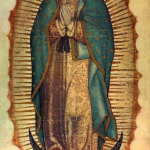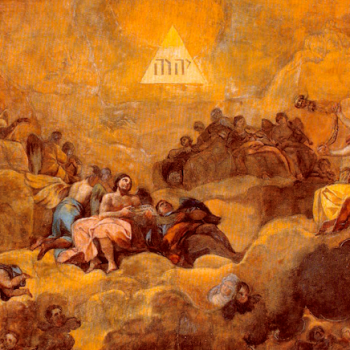Matter Peculiar to St. Mark
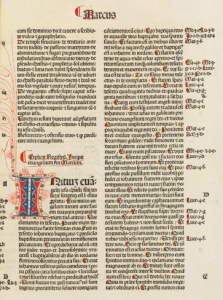
Folio from a late fifteenth-century copy of
the Gospel of Mark, now housed in the
Bodleian Library, Oxford. Image used
under a CC BY 4.0 license (source).
Mark, as we’ve discussed, doesn’t have a lot of unique material. This is part of the reason it is widely regarded as the earliest Gospel. It so happens that, of the two parables related in this past Sunday’s Gospel, the first is peculiar to St. Mark, i.e. he’s our only source for it—though I’ve got a hunch St. Paul was familiar with it too. In any case, this being as good a time as any, let’s briefly review the salient and distinctive traits of Mark:
- No allusion to the Nativity—which is a little ironic, given that Mark does have
- Unique details about Jesus’ family (e.g. mention that Jesus was not only a “carpenter’s son” but a carpenter himself, use of the metronymic* “Son of Mary,” allusion to “sisters” as well as brothers)
- An accent on Jesus’ emotions, including in situations where such information is not clear from his words or actions (e.g. in episodes like the man with the withered hand or the rich young ruler)
- Explanations of Judaic customs, like ritual hand-washing
- A particular tendency to preserve the phrasing used by Jesus, especially in Aramaic (e.g. 5.41, 12.28-31, 15.34)
- Some unique teaching, including sayings and parables (e.g. 2.27, 4.26-29, 8.14-21, 9.49-50), along with a particular concern to oppose the doctrine of the Sadducees
- Conversely, a complete lack of interest in or mention of the Samaritans
- A high proportion of miracles (especially exorcisms), sometimes combined with a command not to disclose them (e.g. 1.43-44, 7.36)
- Special attention to details of chronology (e.g. the sequence of events early on in Holy Week)
- A surprising lack of any direct Resurrection appearances
Mark 4.26-34, RSV-CE

And he said, “The kingdom of God is as if a man should scatter seed upon the ground, and should sleep and rise night and day, and the seed should sprout and grow, he knows not how. The earth produces of itself, first the blade, then the ear, then the full grain in the ear. But when the grain is ripe, at once he puts in the sickle, because the harvest has come.”
And he said, “With what can we compare the kingdom of God, or what parablea shall we use for it? It is like a grain of mustard seed,b which, when sown upon the ground, is the smallest of all the seeds on earth; yet when it is sown it grows up and becomes the greatest of all shrubs,c and puts forth large branches, so that the birds of the air can make nestsd in its shade.”
With many such parables he spoke the word to them, as they were able to hear it; he did not speak to them without a parable, but privately to his own disciples he explained everything.
Mark 4.26-34, my translation
He also said: “The kingship of God is just like a person who casts seed into the earth, and lies down and rises, night and day, and the seed sprouts and grows tall—he does not know how. Of itself the earth bears fruit, first the fodder, then the ear, then the full grain in the ear. Yet whenever the fruit shows, right away he goes in with the sickle, because the harvest has come.”
He also said: “What shall we liken the kingship of God to, or what analogya may we set up for it? Like a mustard-seed,b which, whenever one sows it in the earth, is smaller than all the seeds there are on earth—yet, whenever one sows it, it surmounts and becomes bigger than every vegetable,c and makes large branches, so that the birds of heaven perchd under its shade.”
And he told them the word with many analogies like these, just as they could hear it; he told them nothing without an analogy, but on his own he untangled everything for his own students.
Textual Notes
a. parable/analogy: Though parables certainly qualify as their own “genre” of comparison, this is strictly all the word παραβολή [parabolē] means. (Translating its elements flat-footedly, it comes out to “a throwing together.”) The Bible is not the only book to feature parables, nor Jesus the only Biblical figure to use them. One interpretation of the oddly-placed story of the true and false mothers who pled before Solomon is that it is a political parable, in which the false mother represents Solomon himself and the true mother represents his older half-brother Adonijah, who arguably had a better claim to the throne†: the gist of the parable, on this showing, is that the true mother (Adonijah) should cede the child (the kingdom) to the false mother (Solomon), who is willing to divide it with the sword (wage war for the throne).
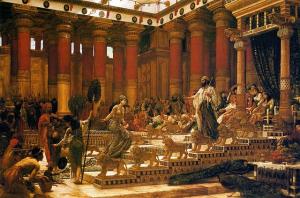
The Visit of the Queen of Sheba to King
Solomon, Edward Poynter, 1890.
Whether or not this is the correct interpretation of the end of I Kings 3, it does illustrate a quality of parables that we frequently encounter in the teaching of Jesus. This is that the comparisons drawn are extremely narrow—they refer to bad things almost as often as good ones! The parables compare God to a corrupt judge, a home invader, and an usurious monarch (one who sounds suspiciously like the tyrant Herod Archelaus); his kingdom to new wine (which is the inferior kind), a very indifferent catch of fish, and yeast (a traditional symbol of impurity); and his own disciples to heretics, dishonest property managers, and tax farmers—to say nothing of how often they are compared to sheep, animals which, justly or not, are famed for their stupidity and excessive docility!
This trend is observable in the second parable here. It was not customary among Jews to grow mustard domestically in gardens, since it is something of a pest: once introduce a mustard plant somewhere it can possibly thrive, and (as Pliny the Elder complained in his Naturalis Historia just a few decades later) it’s nearly impossible to get it out.
b. It is like a grain of mustard seed/Like a mustard-seed: Unlike English, which generally forbids sentence fragments, Greek is relatively laid back about them.
As for “mustard,” it is hard to be certain what plant was intended. Black mustard (Rhamphospermum nigrum) has seeds ranging around 2-3 mm in diameter, while the seeds of the botanically unrelated white mustard (Sinapis alba), from which the modern condiment is made, are closer to 1 mm. (Regardless of what plant was in view, the statement that mustard is the smallest seed is hyperbole: poppy seeds are smaller, and had been well known in the Mediterranean for centuries.)
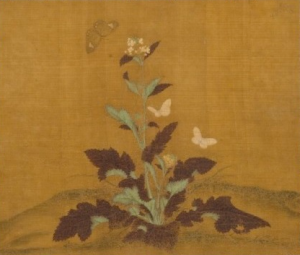
Mustard Plant and Butterflies. Painted
Chinese scroll, artist unknown, early or
middle Ming dynasty (ca. 1368-1550).
c. shrub/vegetable: I opted against “shrub” on the grounds that the Greek term here, λάχανον [lachanon], applies specifically to edible plants (“herb” is another common rendering), whereas no such connotation seems to apply to the English “shrub.” As aforementioned, the exact species is uncertain, if there was a single botanical species intended; and that need not be the case. Ancient taxonomies relied more on traits that ancient societies could observe—appearance, usefulness to humans, etc.—than on traits like descent that they lacked the technology to discover in the first place, and would have been of no use to them even if they had been known.
However, if there is any single species to zero in on as a likely candidate, it is likely the astonishingly versatile crop Brassica oleracea. Some of you already know where this is going! To those who don’t, I’d give you the name of this plant in English, except I don’t know which one to pick: broccoli, or Brussels sprouts, or cabbage, or cauliflower, or collard greens, or gai lan, or kale, or yes there are several more. Brassica oleracea is one of the most widely grown food plants in the world. Many of its varietals are of modern creation, but several were already known in antiquity. (Cato the Elder—the Carthago delenda est guy—was also a fanatical proponent of the medicinal virtues of cabbage.) The broader family, the Brassicaceæ, also embraces other leafy vegetables like arugula, bok choy, and Chinese cabbage, root vegetables like radishes and turnips, and other pungent herbs like black mustard, cress, horseradish, Indian mustard, wasabi, watercress, and white mustard.
(So, yeah, the ancients aren’t the only ones who named plants based on what they used them for and not how they were related to other plants. This has basically nothing to do with the Gospel text. I must be getting rambly.)
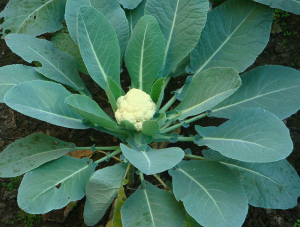
Specimen of Brassica oleracea of the
Botrytis group (characterized by densely-
clustered inflorescences—whatever, you
get it, it’s a frickin’ cauliflower).
d. make nests/perch: “Nest” versus “perch” is, in this context, something of a coin toss—both senses work, especially since “perch” can denote something constant or habitual, especially in the case of domesticated birds. It is probably no more than an entertaining coincidence, but it is an entertaining coincidence, that the verb in question (κατασκηνόω [kataskēnoō]) is a modified form of the same verb (σκηνόω [skēnoō]) that appears in John 1.14 to say the Logos “dwelt” among us; the most literal translation for it would be “to pitch one’s tent.”
Footnotes
*A metronymic is the maternal equivalent of a patronymic, i.e. a name-form indicating the name of one’s father. (The form “matronymic” is also used, probably under the influence of the Latin mater, but this word is drawn from Greek, whose word for mother is μήτηρ [mētēr].) Some cultures’ naming customs include patronymics or metronymics by default. In English, surnames are traditionally passed along patrilineally, but in the feudal period (when surnames were more along the lines of a Latin cognomen), metronymics were occasionally used, especially if a person’s mother were of unusual importance: King Henry II was the son of Empress Matilda and was surnamed “fitzEmpress.” In the Holy Land during the first century, the norm in Aramaic was to refer to people by given name and patronymic, e.g. Yeshuwaȝ bar-Yoseph [יֵשׁוּעַ בַּר-יוֹסֵף], but, since bar simply meant “son of,” it was equally possible to insert the mother’s name, e.g. Yeshuwaȝ bar-Miryam [יֵשׁוּעַ בַּר-מִרְיָם].**
**The character ȝ here, named “yogh,” is an obsolete letter of the English alphabet, the original sound of which was a soft buzz, related to g the way v is related to b. Since the Hebrew letter ע (named ‘ayin or, in this system, ȝayin) may have made a similar soft buzzing sound, a sound which (like yogh) has been lost in Modern Hebrew, it struck me as a logical choice for transcription.
†Adonijah was David’s fourth son, born during the conflict with Saul. His three elder brothers were Amnon, Chileab, and Absalom: Chileab (also known as Daniel) is thought to have died young, while Amnon was murdered by Absalom, who was in turn killed by David’s old companion Joab after attempting to usurp the throne. This left Adonijah as David’s eldest surviving son at his death, making it natural for him and others to presume he was the heir.
A complicating factor is that primogeniture was a ground to advance a claim to the throne, but there were others, and in Israel at the time there was no real precedent to follow for the succession. (To date, there had only been two monarchs recognized by all twelve tribes—Saul and David—and they had not been related: outside Judah, David had been accepted as king by right of conquest, but not necessarily by the divine right he claimed, and certainly not by inheritance.) One alternative is the principle of porphyrogeniture, literally “birth in the purple,” in which the eldest son born during his father’s reign is the heir presumptive. Porphyrogeniture was the legal norm later on in the Byzantine Empire, for instance. Nomination by the sitting monarch before his death was also common, and usually decisive. As in Bathsheba’s case, the king’s wives—who, due to the practice of polygamy, were princesses rather than queens (a custom still observed in Morocco)—might be influential in this process; the mother of the prince who became king would normally be appointed queen, since she represented the continuity of the dynasty (in contrast to European traditions, in which the queen of a realm always means either a queen reigning in her own right or a king’s consort).


